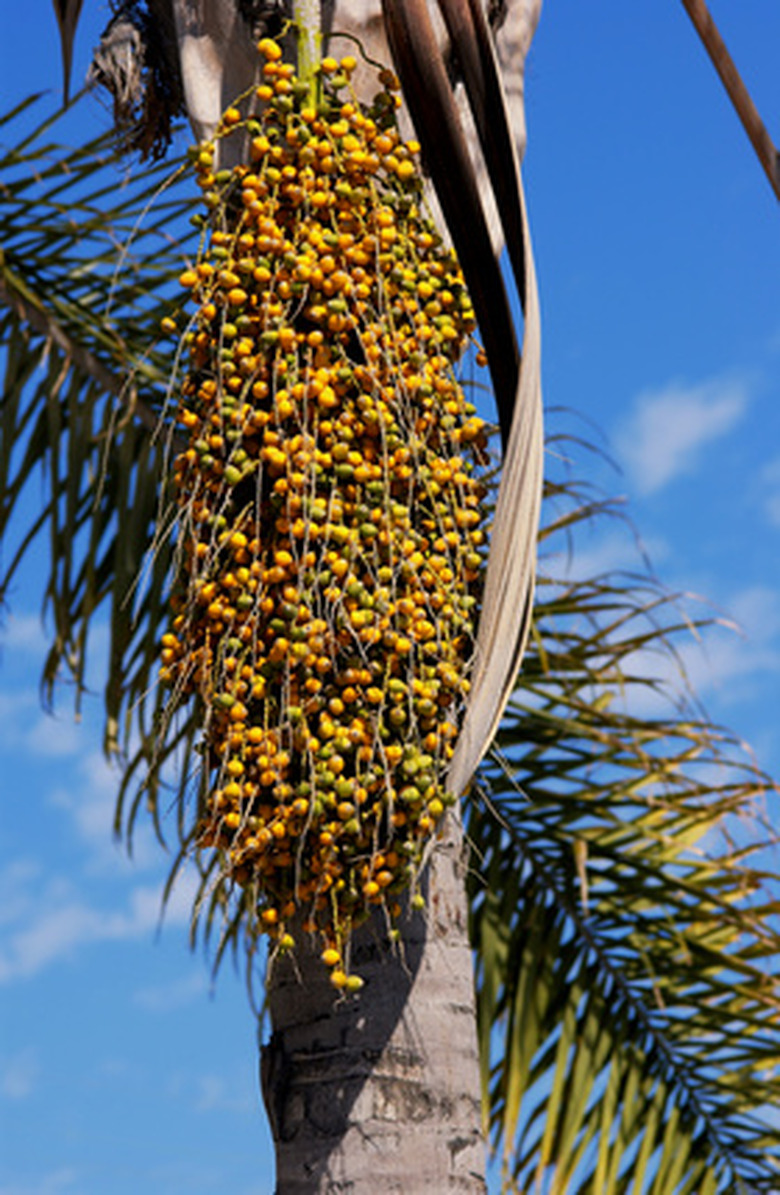Arizona Queen Palm Tree Care
Rivaling the coconut palm's beauty in leaf silhouette, the queen palm (Syagrus romanzoffianum) is an inexpensive palm option for the warmest regions of Arizona. This palm's susceptibility to winter cold finds it growing best only in southwestern Arizona, at elevations below 2,500 feet, such as in locations like Yuma or Phoenix. It does well only the warmest parts of U.S. Department of Agriculture hardiness zones 9 and warmer or in Sunset climate zones 12 and 13. For a more visually dramatic display, plant the tall, straight-trunked queen palms in clusters of three or five, all with varying heights.
Protection in the Garden
Queen palms in Arizona are often grown in irrigated landscape beds or as tropical shade trees jetting up from turf lawns. The trunks of palms differ from those of woody trees in that they lack the thick, protective bark, or cambium layer. Thus, any wounds sustained on the queen palm trunk from a weed cutting string or lawn mower chute are permanent. These wounds can be avenues of entrance for both diseases and pests. You can create a protective, flat circle of organic mulch around the trunk as recommended by the University of Arizona. Make the radius of at least 12 inches, so that blades or mowers do not need to get too close to the palm trunks during their usual maintenance duties.
- Rivaling the coconut palm's beauty in leaf silhouette, the queen palm (Syagrus romanzoffianum) is an inexpensive palm option for the warmest regions of Arizona.
Water Regimens
Effective irrigation of the roots around queen palms encourages roots to extend at least 4 feet out from the trunk, according to the University of Arizona. Any drip irrigation heads should stay 4 feet from the trunk and should run for sufficient time to ensure that moisture penetrates to at least a 2-foot depth in the soil. Supply water to queen palms once every two weeks in the heat of summer and every four to six weeks during the winter months.
Fertilizer Considerations
Nitrogen is typically the most lacking nutrient in Arizona soils. The University of Arizona suggests using a "palm special" granular fertilizer with three times more nitrogen and potassium than phosphorus. If your soil pH is not acidic, magnesium, manganese and iron deficiencies lead to pale colored fronds and newly emerging fronds looks ragged–a condition called "frizzle top." Applying the well-balanced palm fertilizer according to product label directions in mid-spring and again in early summer, to proactively keep the soil nutritional levels ideal. Faster, lusher frond growth always occurs on queen palms supplied with ample amounts of nitrogen and iron in Arizona soils.
- Effective irrigation of the roots around queen palms encourages roots to extend at least 4 feet out from the trunk, according to the University of Arizona.
- Faster, lusher frond growth always occurs on queen palms supplied with ample amounts of nitrogen and iron in Arizona soils.
Pruning Maintenance
Older, lowermost fronds in the queen palm canopy are the first to wither and brown with age. They become yellow and then dry and collapse to remain flush against the top of the trunk before dropping to the ground. Allow yellowing fronds to remain on the tree, as nutrients are pulled from the dying fronds and used elsewhere in the plant. If you choose to prune the shape of the palm's canopy, cut away only those fronds that are held at an angle below horizontal. Overpruning of queen palms leads to increased wind damage, slower growth, and a narrowing of the trunk called "pencil necking" because of the lack of fronds making food for the plant to grow bigger. Flower or fruit stalks can be pruned away at any time based on personal aesthetics.
Winter Hardiness
Young queen palms tend to be exposed to colder temperatures in winter since they are lower to the ground, where the coldest air pools. Palms with tall trunks often escape the frost or subfreezing temperatures. According to the "Sunset Western Garden Book," queen palms sustain frond damage (die back) when exposed to air temperatures at or below 25 degrees Fahrenheit, but some plants do recover from freezes as low as 16 F. The palms will lose most if not all their fronds and will send out new fronds in late spring, once temperatures are significantly warmer.
- Older, lowermost fronds in the queen palm canopy are the first to wither and brown with age.
- According to the "Sunset Western Garden Book," queen palms sustain frond damage (die back) when exposed to air temperatures at or below 25 degrees Fahrenheit, but some plants do recover from freezes as low as 16 F. The palms will lose most if not all their fronds and will send out new fronds in late spring, once temperatures are significantly warmer.
Insect Concerns
Pay particular attention to young queen palms in Arizona during the hot, arid weather for infestations of mites in the fond leaflets. An excellent preventive measure to diminish mite numbers is to wash palm fronds weekly with a spray of water to kill and displace mites.
References
- University of Arizona: Arizona Landscape Palms
- "An Encyclopedia of Cultivated Palms"; Robert Lee Riffle and Paul Craft; 2003
- "Sunset Western Garden Book"; Kathleen Norris Brenzel, ed.; 2007
